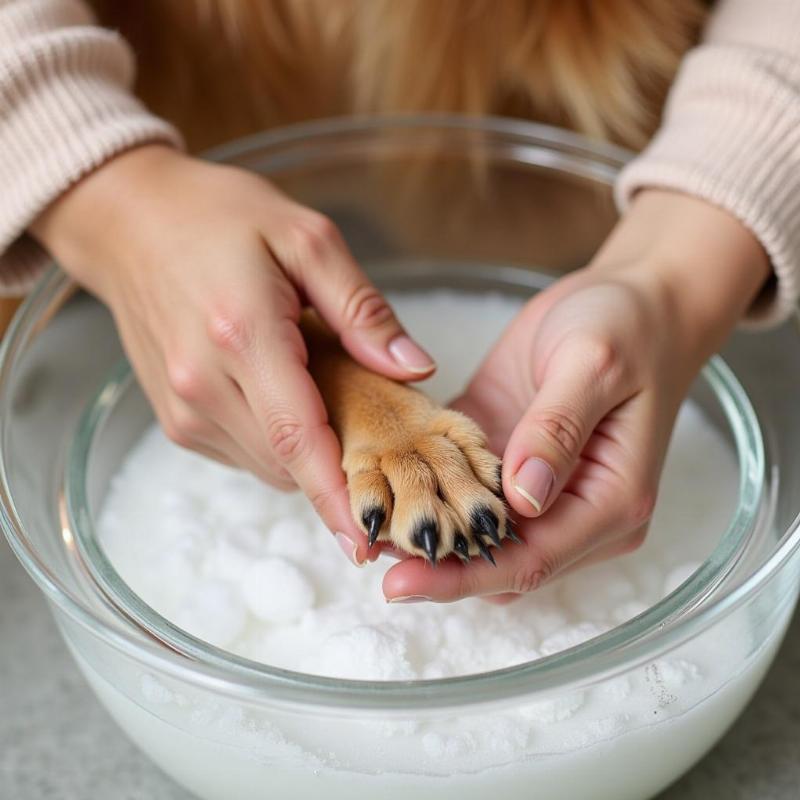Red and swollen dog paws can be a common concern for pet owners. Understanding the underlying causes, knowing when to seek veterinary care, and implementing preventative measures are crucial for ensuring your furry friend’s comfort and well-being. This article provides a comprehensive guide to help you navigate this issue and keep your dog’s paws healthy.
Understanding the Causes of Red and Swollen Paws in Dogs
Various factors can contribute to red and swollen paws in dogs. Allergies, infections, injuries, and even parasites can be culprits. Accurately identifying the cause is the first step towards effective treatment.
Allergies
Environmental and food allergies are common triggers for paw inflammation. Pollen, dust mites, mold, and certain food ingredients can cause allergic reactions manifesting as red, itchy, and swollen paws.
Infections
Bacterial and fungal infections can also lead to paw inflammation. These infections can thrive in moist environments between the paw pads.
Injuries
Foreign objects like thorns, splinters, or glass shards can become lodged in a dog’s paw, causing pain, swelling, and redness. Trauma from excessive licking or chewing can also contribute to inflammation.
Parasites
Mites, ticks, and fleas can irritate a dog’s paws, leading to redness, swelling, and intense itching.
When to Seek Veterinary Care
While some cases of mild paw irritation may resolve on their own, it’s crucial to know when professional veterinary care is necessary. If your dog’s paw swelling is severe, accompanied by limping, bleeding, or a foul odor, consult a veterinarian immediately. Similarly, if the redness and swelling persist for more than a few days, a veterinary examination is recommended.
Treating Red and Swollen Dog Paws
Treatment depends on the underlying cause. Your veterinarian may prescribe antibiotics for bacterial infections, antifungals for fungal infections, or antihistamines for allergies. Pain relievers may also be necessary to manage discomfort. For injuries, removing the foreign object and cleaning the wound is crucial.
Home Remedies for Mild Paw Irritation
For mild cases, soaking the affected paw in warm water with Epsom salts can help soothe inflammation. Applying a vet-approved paw balm can also provide relief and protect the paw from further irritation. Always consult with your veterinarian before trying any home remedies.
 Treating a swollen dog paw
Treating a swollen dog paw
Preventing Red and Swollen Paws
Regular paw care is essential for preventing inflammation. Keep your dog’s paws clean and dry, especially after walks. Trim the hair between the paw pads to prevent matting and moisture buildup. Regularly check your dog’s paws for any foreign objects, cuts, or signs of irritation.
Protecting Paws from Environmental Irritants
During walks, consider using dog booties to protect your dog’s paws from harsh weather conditions, hot pavement, and potential allergens. After walks, wipe your dog’s paws with a damp cloth to remove any irritants.
Conclusion
Red and swollen dog paws can be a sign of various underlying issues, ranging from allergies to infections and injuries. Prompt identification of the cause and appropriate treatment are essential for ensuring your dog’s comfort and well-being. Regular paw care and preventative measures can significantly reduce the risk of future paw problems. By understanding the information presented in this article, you can help keep your furry friend’s paws healthy and happy.
FAQ
-
What can I put on my dog’s swollen paw? Consult your veterinarian before applying anything to your dog’s paw. They may recommend a vet-approved paw balm or other treatment.
-
How can I tell if my dog’s paw is infected? Signs of infection include severe swelling, redness, heat, pus, bleeding, or a foul odor.
-
Can I use Neosporin on my dog’s paw? While small amounts of Neosporin may be safe, it’s best to consult your veterinarian for appropriate treatment.
-
Why are my dog’s paws always red and itchy? Allergies are a common cause of red and itchy paws in dogs.
-
How can I prevent my dog from licking his swollen paw? An Elizabethan collar (cone) can prevent your dog from licking the affected area.
-
What are the signs of an allergic reaction in a dog’s paw? Redness, swelling, itching, licking, and chewing are common signs of paw allergies in dogs.
-
When should I take my dog to the vet for swollen paws? If the swelling is severe, accompanied by limping, bleeding, a foul odor, or persists for more than a few days, consult your veterinarian.
Beautdogs.us – your trusted source for comprehensive dog care in the US. We provide expert guidance on various dog breeds, from common to rare, along with in-depth knowledge on health care, nutrition, and training. Our platform offers practical advice on responsible pet ownership, including legal matters and financial planning. We also review and recommend quality pet products, from food to grooming supplies. Whether you are a new dog owner or an experienced one, Beautdogs.us is the go-to destination for all things dog-related. When you need assistance, contact us via Email at [email protected] for detailed and accurate answers.